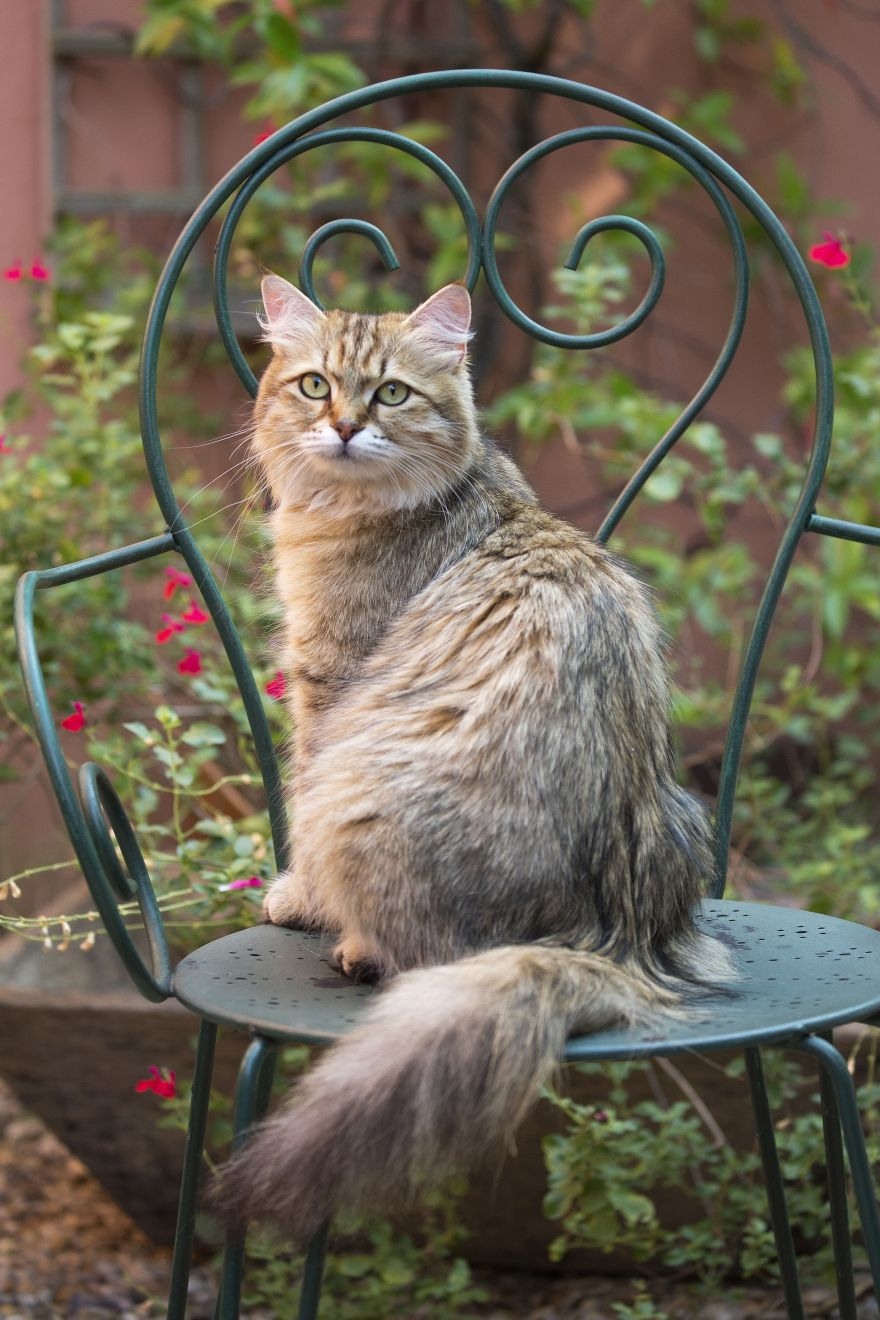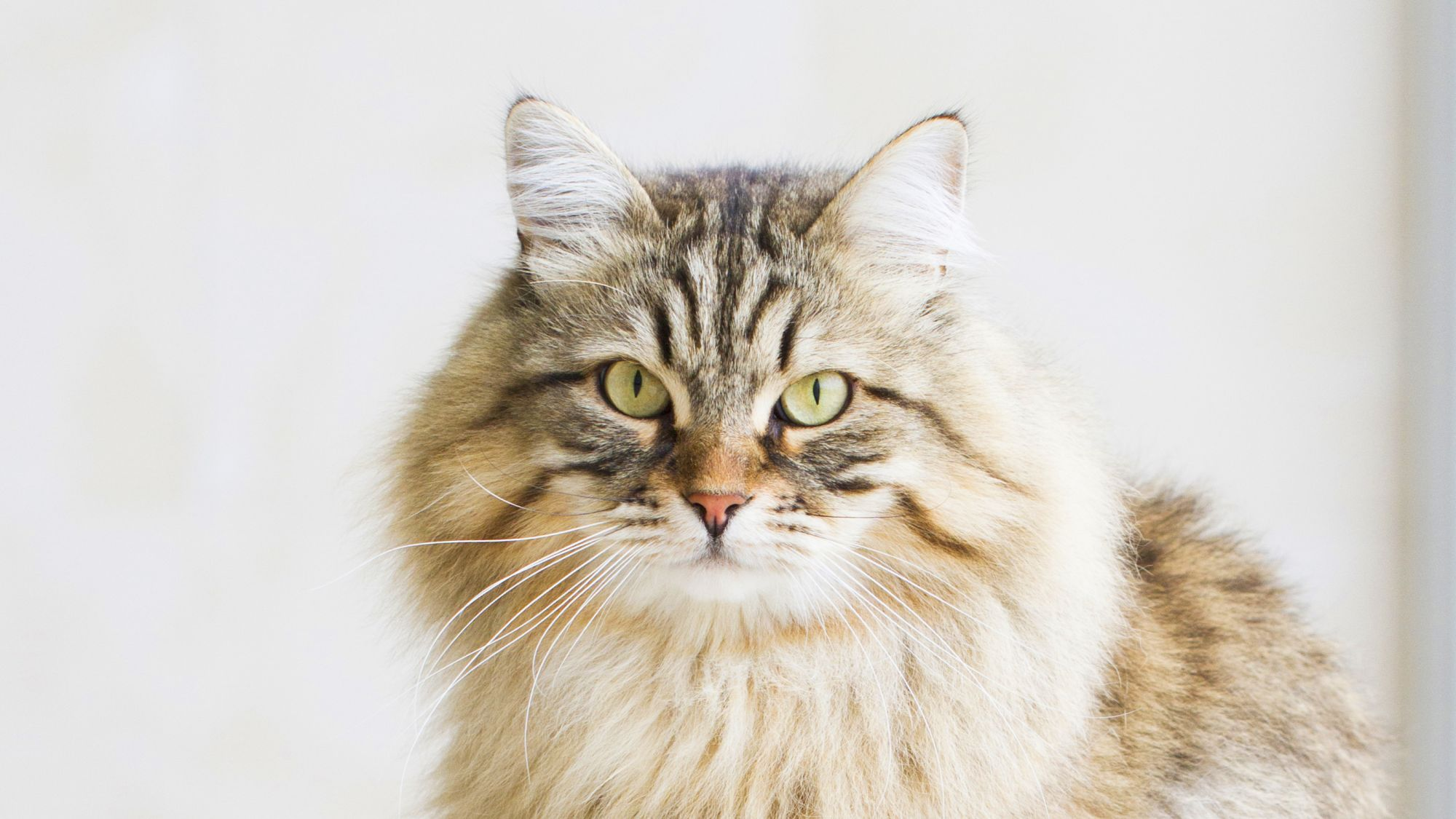Let's talk Siberians
The Siberian cat’s thick and lustrous coat is not just for show – although it is magnificent. Over the centuries, this ancient breed developed a triple-layer insulating and waterproof fur coat, ideal for withstanding the harsh climate of its native Siberia. If their ancestors evolved for the rugged, outdoor life, these days, Siberians certainly appreciate more comfortable conditions – these affectionate cats can be playful but are mostly quite content curled up in the warm, near their owners, always ready for a snuggle.
Official name: Siberian
Other names: Neva Masquerade (pointed variety), Siberian Forest Cat
Origins: Russia
Shedding Level
4 out of 5Physical activity needs
1 out of 5Compatibility with other pets
4 out of 5Warm weather?
2 out of 5Kid-friendly
5 out of 5
| Male | Female |
|---|---|
| Height | Height |
| 10 - 12 in | 9 - 11 in |
| Weight | Weight |
| 15 - 20 lb | 10 - 15 lb |
| Life stages | |
|---|---|
| Kitten | Adult |
| Birth to 12 months | 1 to 7 years |
| Mature | Senior |
| 7 to 12 years | From 12 years |
Tailored nutrition for your Siberian
Get to know the Siberian
All you need to know about the breed
With their extravagant fur coats, wide round eyes, fluffy ears and impressive brush-like tails, Siberian cats are true Russian beauties. But if you’re expecting an icy temperament to match their icy Siberian origins, you’re in for a bit of a shock. These wonderful cats are big softies who just want to be close to their chosen humans – they will literally follow you around the house and snuggle up on your lap, offering themselves up as a sort of feline hot water bottle.
Siberian cats will even ‘talk’ to you. Siberians communicate with their humans through sweet little chirps and harrumphs as well as the more conventional purrs and miaows.
Gregarious Siberians get on well with other animals and children too. They are playful and athletic by nature and that may sometimes translate into energetic leaps onto the furniture or frenzied batting at the cursor on your computer. However, these cats also have a calm, placid side. No wonder the Siberian breed is sometimes put to use as a therapy cat.
Two facts about Siberians
1. From Russia with gloves
Actually gloves might be the only thing missing from the Siberian’s winter wardrobe. This warm-hearted cat’s weather-proof clothing is impressive: a triple-layer, water-repellent coat, a full ruff, fluffy breeches and a fox-like bushy tail. Tufted paw pads complete the Siberian’s outdoor equipment, there to help them walk across the snowy landscape before they got to you.
2. Lynx-tipped Neva Masquerade
No, it’s not a secret code, but a way of describing a Siberian cat with distinctive markings and tufty ears. The alternative name Neva Masquerade is used for Siberians with darker fur on their extremities (also known as pointed). And if your cat has little tufts of hair on the tips of their ears then they have something in common with their bigger, wilder (distant) cousin, the lynx. These tufts, which help keep cats’ ears clear of dirt, are known as Lynx Tips.
History of the breed
Siberian cats date back at least a thousand years and are thought to be related to the Norwegian Forest Cat: the physical similarities between the two breeds are obvious and they both evolved to withstand harsh cold environments.
Siberian cats have long been popular multitaskers in their homeland of Russia, from farm cats to much-loved family pets, even making magical appearances in local folklore and fairy tales.
Although some had been shown at cat shows as far back as the 1870s, it was only after the end of the Cold War that these fabulous felines really started to be more widely known as some Siberian cats were exported to Europe and the United States. The Cat Fanciers’ Association accepted the breed for registration in 2000 and the breed made it to championship status in 2006.
From head to tail
Physical characteristics of Siberian cats
1.Tail
2.Ears
3.Coat

Things to look out for
From specific breed traits to a general health overview, here are some interesting facts about your Siberian
Heart trouble
Siberians are generally healthy cats but the breed is among those prone to a condition called hypertrophic cardiomyopathy, a form of heart disease that causes the heart muscle to enlarge, decreasing its efficiency. Always try to buy from a reputable breeder who will take care to only breed from disease-free parents.
Watch the pounds
Siberians are a naturally big breed and may be at risk of putting on too much weight, which can lead to health problems. Make sure your cat eats the right food and in the right quantities to ensure they stay in the best of health. Regular check-ups with your vet are always a good idea.
Tailored nutrition for Siberians

Tailored health nutrition has a fundamental role to play in maintaining the health and beauty of Siberian cats. Food provides energy to help with vital functions and a complete nutritional formula for Siberians should contain an adapted balance of nutrients. Feeding them in this way will offer a diet that's neither deficient nor excessive, both of which could have adverse effects on your cat's health.
The following recommendations are for healthy animals. If your cat has health problems, please consult your veterinarian who may recommend an exclusively veterinary diet.
Strong Immune System
Supports the development of the kitten's healthy immune system with the inclusion of clinically proven antioxidants, including vitamins E and C.
Healthy Growth
At 4 months old, a kitten's growth rate changes with rising energy levels to support growing bones and muscles. This formula contains an adapted level of protein, vitamins and minerals for the final stage of kittenhood until 1 year old.
Microbiome Support
Combination of prebiotics & highly digestible proteins to help promote a healthy balance of intestinal microbiota for digestive health.

The main nutrition goals for adult Siberians are:
Stool Odor Reduction
A lack of exercise may lead to a slower intestinal transit which can result in smelly stools. Indoor Adult is formulated with highly digestible protein (L.I.P.*), an appropriate fiber content and specific nutrients to promote good digestion and help reduce the quantity and odor of stools. *Protein selected for its very high digestibility.
Moderate Calorie
A moderate fat content adapted to the lower activity of indoor cats to help maintain healthy weight.
Manages Hairballs
A combination of different types of fibers that encourages intestinal transit and helps facilitate the elimination of the hair your cat swallows every day.

A senior Siberian cat - one over the age of 12 - may sometimes have difficulties with absorption. To maintain the weight of the aging cat and minimize the risk of deficiency, they should be given an extremely digestible food filled with essential nutrients.
Weight Maintenance
In some senior cats, the level of activity reduces with age, which leads to weight gain. Aging Spayed/Neutered 12+ contains a moderate level of fat to help maintain an ideal body condition.
Healthy Aging Complex
An exclusive complex of antioxidants including lycopene and omega-3 fatty acids to support the body systems through the aging process.
Renal Health
Helps support healthy renal function with a moderate phosphorus level.
Enriched with L-Carnitine
L-carnitine is involved in healthy fat metabolism.

Caring for your Siberian
Grooming, training and exercise tips
Keeping that wonderfully thick Siberian coat in good condition doesn’t take as much effort as you might expect: a brush or comb twice a week should ensure it stays tangle free. During shedding season, you may need to increase the frequency. Regular ear and teeth cleaning (daily if possible) and nail trimming are important too, and your cat needs to have access to a scratching post to allow them to fulfil their instinctive need to scratch. Siberians are playful cats and appreciate the chance to run and jump or chase a toy. If you have the patience, Siberian cats can easily master obedience commands and tricks – good for their mental stimulation.
7/7
All about Siberians
Not really – Siberians’ coats may be thick and impressive but they only need a quick brush every few days to stay in good, knot-free condition. In shedding season (twice a year) expect to do a little more brushing and probably a LOT more vacuuming.
No cats can be considered truly hypoallergenic. However, anecdotal evidence suggests the Siberian breed may not elicit such strong reactions in people with allergies as other breeds. That may be because Siberians have lower levels of the allergy-causing protein in their saliva and skin than other cats – but scientists are still researching the phenomenon.
Other breeds that might interest you
Read more on this topic
Sources
- Veterinary Centers of America https://vcahospitals.com/
- Royal Canin Cat Encyclopaedia. Ed 2010 and 2020
- Banfield Pet Hospital https://www.banfield.com/
- Royal Canin BHN Product Book
Like & share this page